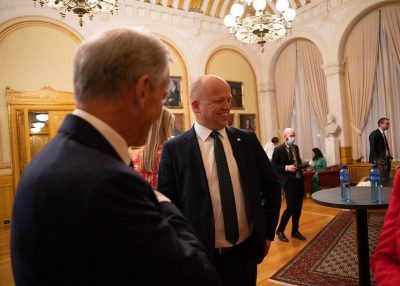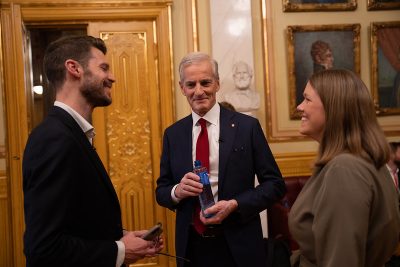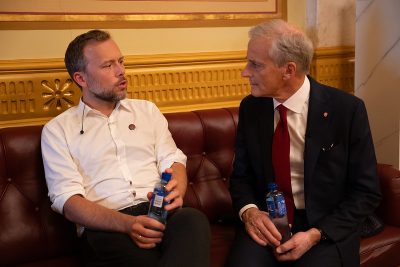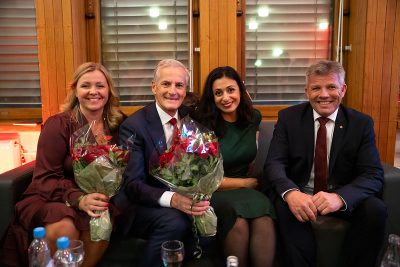By Thursday afternoon, the man set to become Norway’s next prime minister had met with both of his most likely partners in a new left-center government. Jonas Gahr Støre will need to use all his well-known diplomatic skills to form his favoured coalition, given all the differences between the Center and Socialist Left parties and his own Labour.

The latest to visit Støre at his home in Oslo’s affluent Ris district was Audun Lysbakken, leader of the Socialist Left (SV). On Wednesday evening, both the Center Party’s leader Trygve Slagsvold Vedum and Center veteran Marit Arnstad came to call.
Støre told reporters he’d also be meeting with the leaders of the two other, more radical, parties on the left side of Norwegian politics, Bjørnar Moxnes of the Reds and Une Bastholm of the Greens. The latter has already stated that her party, which ended up performing poorly in Monday’s election, won’t support any government that doesn’t agree to halt ongoing oil exploration. Both Labour and Center fully intend to keep drilling.

Moxnes, however, has made it clear he’s ready to hash out issues and even support a government led by Labour, as long as the Reds win support for some of their positions. The Reds, out of principle, don’t want to join any government, since their ideology doesn’t support a capitalist system. Under Moxnes, however, the Reds have become more cooperative and respected players in Parliament.
There’s no question Labour can flex the most muscle in formal negotiations with Center and SV. Labour won twice as many votes as Center did, and Center won nearly twice as many as SV. Labour holds more voter mandates than Center and SV combined. The relatively mild-mannered Støre isn’t likely to blatantly boast about that, but shouldn’t need to remind Center and SV of where they stand either.
“I’m not coming to any conclusions (on a coalition with Center and SV) now,” Støre told reporters after meeting Lysbakken and Vedum. “I think it’s correct to do this well, and important to seriously follow the mandate voters have given us. So we’ll decide later (whether there are grounds for actual government negotiations).”

Lysbakken of SV made it clear he’s ready to negotiate, calling his meeting with Støre both “pleasant and constructive.” He said he thinks it’s natural for Labour, Center and SV to get together, since they’d have a majority in Parliament, “but we’re relaxed about this, and we have plenty of time.” The most important thing for his party, he said, is to move forward with a “green shift” for Norway and reduce social differences among Norwegians.
Center’s Vedum has been most keen on forming a government only with Labour and excluding SV. Commentators now think that may be mostly a bargaining tool, since Labour and Center would not have a majority without SV. Vedum emerged from his meeting with Støre Wednesday night flashing his characteristic grin and claiming they’d had “a good conversation.” He told reporters on Thursday that his party has given him the authority he needs “to move forward with the policies we stand for.” SV has received the same.
They all agree on reducing social differences (probably through higher taxes on the wealthy and lower on those with incomes below NOK 700,000 a year). Center and SV differ, though, on what assets should be included when calculating Norway’s fortune tax on total net worth. SV also wants to reimpose inheritance tax in Norway, but neither Labour, Center nor any of the non-socialist parties support that.
Here’s a rundown of the other main issues up for negotiation:
OIL AND CLIMATE: These were also the most hotly contested policy issues when Labour, Center and SV shared government power from 2005 to 2013. SV usually came out on the losing side, since it was smallest of the three and still is. SV failed at that time, for example, to steer state oil company Statoil (now Equinor) away from its controversial tar sands projects in Canada and fracking in the US (it has since pulled out of land-based oil projects after suffering huge losses in North America). It did help prevent oil drilling off Lofoten and some of the other most scenic coastlines of Northern Norway.
Now the same three parties (Center held the Oil Minister’s post throughout the former left-center government’s eight years ) still disagree on oil exploration and production in the Arctic and Norway’s other offshore areas, with SV advocating the end to drilling that’s also advocated by the UN, the International Energy Agency (IEA) and many others around the world. While Labour and SV agree on a need for much higher carbon taxes, the pro-oil Center Party resists them, and also wants to avoid more taxes that would make diesel and gasoline even more expensive than they already are in Norway.
Climate conflicts also abound within both Labour and Center, with many of their members complaining that their climate policy has been poor and needs to get tougher on the oil industry. Center does support the huge investment proposed for a carbon capture and storage plant at both the large Klemetsrud garbarge and recycling plant in Oslo and an industrial site in Brevik, however, and wants to ban all emissions from Norwegian oil fields from 2040.
WILDLIFE AND NATURE CONSERVATION: The Center Party still wants to shoot wolves and other predators that threaten its farming constituency’s open sheep grazing traditions, and it also resists conservation of at least 10 percent of Norway’s vast forestland. SV wants to protect and nurture Norwegian wildlife while Labour is more willing to control the predator population.
EU/EEA and INTERNATIONAL COOPERATION: Labour was in favour of EU membership before Norwegians turned it down for the second time in 1994 and still strongly supports Norway’s trade and policy agreement with the EU (called the EØS/EEA agreement). Both Center and SV strongly oppose EU membership and want to “improve” or even replace the EØS pact with a pure trade deal. That’s unlikely, since public support for it is high. Center also opposes Norway’s current adherence to the EU’s climate policy.
DEFENSE AND NATO MEMBERSHIP: SV has always opposed Norway’s membership in NATO and its close defense ties to the US, but both are firmly supported by most all other parties in Parliament including Center and Labour. Center also wants to channel far more defense spending to Norway’s northern areas and reverse the decision to close the Andøya air station. Labour mostly went along with the former Conservative government’s reorganization of military bases and allowance of rotating US forces stationed at them, signalling disputes among the three parties on various defense issues.
MAJOR INVESTMENTS AND GOVERNMENT SPENDING: Arguments are expected over everything from defense spending to social welfare issues, like free after-school programs for children (favoured by SV), financial support for parents who don’t send their children to day care centers (opposed by Labour and SV but supported by Center) and major transportation projects like a proposed train line north to Tromsø, expanded highways and more bridges and tunnels to replace ferries (Center supports most of that, not always SV and Labour). The biggest challenge facing all parties in Parliament involves learning to operate without dipping into Norway’s huge sovereign wealth fund known as the Oil Fund too often. Use of oil money saved up for future generations soared during the Corona crisis but must be reduced, not least since oil revenues themselves will decline in the decades to come.
REVERSING RECENT REFORMS: Center and to a large degree SV opposed all the reform and consolidation programs ushered in by the Conservatives-led government over the past eight years. They were aimed at creating more economy of scale and more efficient government services, but now Center especially wants to reopen closed police stations, schools and courts and break up many of the forced county and municipal mergers. Labour may be skeptical.
ASYLUM AND IMMIGRATION: Closed borders in Southern Europe and especially during the Corona crisis all but cut off the flow of asylum seekers making their way to Norway. With millions of people around the world needing protection, however, wealthy Norway is under pressure to accept far more than the few thousand the country currently does. SV is strongly in favour of welcoming more asylum seekers and other immigrants, while Labour is more restrictive. So is Center, even though many local Center Party mayors around Norway want more of both because of all the state support they receive and because they can help repopulate remote areas and boost the local workforce.
WELFARE AND WORK ISSUES: SV is by far the most liberal in this area, advocating higher unemployment and welfare benefits to those needing them, while Labour and Center are more restrictive. Labour and SV agree on the need for organized labour and workplace rules. There’s also pressure to form new housing policy to help more young people break into an expensive real estate market without having to rely on parental contributions. The Reds Party also initiated a drive even before the election campaign began to have dental care included in the Norway’s overall health care system, in which the state covers most expenses. Polls show that fully 80 percent of Norwegians think dental care should be made available to those with low incomes.
SOCIAL VALUE ISSUES: Labour and SV want to do away with the current authorities who decide whether women can have late-term abortions, while Center wants to retain them. Center is also skeptical about biotechnology issues involving egg donation and early testing of a fetus. SV wants to decriminalize use of narcotics while Center and Labour are opposed. There’s also strong conflict within Labour on the latter.
Conflict also remains within Center and its leadership over whether the party should even try again to cooperate with SV in government or try to rule solely with Labour in a minority government. Former Center Party leader Liv Signe Navarsete strongly supports cooperation with SV and doesn’t think Center communicated its own climate policy well enough.
“Many have claimed SV is so difficult to cooperate with, but my experience (as a minister in the former left-center government) was that it was just as easy and difficult to cooperate with Labour,” Navarsete told newspaper Klassekampen this week. “We disagree with SV on many issues but we also agree on many.” In the end, she claims, the three parties shared many values and complemented one another.
There’s lots of other support for the three-party coalition Støre wants to build, if only to avoid constant conflict when a minority government needs to rule on an issue-by-issue basis. Støre’s own Labour Party appears united behind the three-party red-green coalition as does SV, although it plans to have its membership vote in a referendum of sorts on a potential platform to make sure it’s firmly anchored within the rank and file.

Støre, a former foreign minister known for his diplomatic skills and willingness to listen to others’ views, appears well-suited to tackle the task of bringing the coalition together. “Jonas Gahr Støre is the right man to gather people around a table and create agreement, that’s one of his foremost talents,” his deputy Labour leader Hadia Tajik told reporters this week. Støre constantly stresses a need for dialogue, and already is emphasizing confidental conversations among the potential partners and taking the time needed to settle differences.
“I’ll begin by listening to how they (Vedum and Lysbakken) sum up the election,” Støre told reporters after a Labour board meeting right after the party’s election victory. “I also have some thoughts about how we can move forward on the basis of that.”
Newspaper Aftenposten editorialized this week that Støre, sometimes viewed as wavering on issues, must stand firm and not make too many concessions to any “junior partners” in the government. “Norway doesn’t need to reverse all the reforms (made by the current government),” calling many of them “sensible” and worth preserving. “The country also needs international cooperation,” Aftenposten warned, perhaps fearing that Center and its rural sympathies will take Norway in a more nationalist, protectionist and even provincial direction. “Labour must stand firmly on its foundation and not give in too much to either Center or SV.”
Actual negotiations are expected to begin at the end of next week, when Støre hopes the three party leaders can retreat to a neutral location to hammer out a government platform. An actual transfer of power from the current Conservatives-led government to one led by Støre would probably occur in mid-October, after Parliament reopens and after presentation of a state budget proposal for next year.
newsinenglish.no/Nina Berglund

